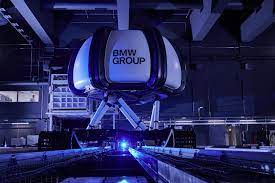Driving the car inside the simulator not only looks real, as the driver is inside a real car doing realistic driving and seeing high-fidelity imagery of the real world outside, but it also feels real, as the Sapphire’s systems can produce 0.65 G of acceleration. That creates the feeling of accelerating, braking, and turning at believably high levels. The 183,000-lb. apparatus consumes 6.5 megawatts of power as it runs.
Engineers oversee testing and operate Sapphire from an adjacent control room. They cannot only see the simulator in action through the window, but they have monitors showing the view from inside the car that is in the bubble. They also have computer displays providing data on the test as it is happening. From here, operators can change variables such as the weather, the road surface, the tires, the season, and the time of day.
The sims’ slides are powered by linear electric motors that create alternating magnetic fields to move them. Power comes from supercapacitors that can quickly dump the huge amount of electricity needed to move the hexapod platform and car rapidly.
While simulators might look like excellent toys to the rest of us, they are critical tools for carmakers like BMW. “We see the driving simulator as a time machine because it lets us drive the car of the future,” explains Martin Wahle, head of Virtualization and Driving Simulator.
Source : https://www.popsci.com/technology/bmw-driving-simulation-centre-munich-germany/









